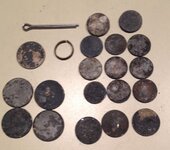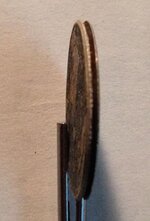FloridaMike
Jr. Member
- Apr 8, 2014
- 74
- 53
- Detector(s) used
- Coinmaster 6000/D, Excalibur II
- Primary Interest:
- Beach & Shallow Water Hunting
Today was my first day using an Excalibur in the water.
Still learning how to use it but found some things.

Highly mineralized coins, a SS cotter pin, a toe ring, my first ring and I'm pretty sure it's silver.
It's hard to tell which of the coins are pennies and which are dimes.
One of the coins is a 1996 Quarter and it has a groove all the way around the edge.

I figure something in the water dissolved it as it was quite crusted up and looked like it was there a long time.
If anyone can confirm this please pipe up.
I can't wait to go back and see what else I can find.
Mike
Still learning how to use it but found some things.

Highly mineralized coins, a SS cotter pin, a toe ring, my first ring and I'm pretty sure it's silver.
It's hard to tell which of the coins are pennies and which are dimes.
One of the coins is a 1996 Quarter and it has a groove all the way around the edge.

I figure something in the water dissolved it as it was quite crusted up and looked like it was there a long time.
If anyone can confirm this please pipe up.
I can't wait to go back and see what else I can find.
Mike
Amazon Forum Fav 👍
Upvote
2




